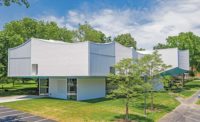Nanotech Center Raises the Curtain on Research








With the opening of the Krishna P. Singh Center for Nanotechnology, students and the general public are getting a rare glimpse into research practices at the University of Pennsylvania. In designing and building a facility with a very open layout and visible laboratory spaces, the team has created a space that defies conventional thinking about research facilities.
Todd Hoehn, senior project manager at architect Weiss/Manfredi, says that while laboratories are typically designed to be isolated from view, the school wanted to pull back the curtain and let the public experience the process. "The underlying concept is to take a typical nanotech lab, turn it inside out and make it visible," he says.
Prominently located at the corner of 33rd and Walnut Streets in Philadelphia, the 78,000-sq-ft, three-story facility includes laboratory spaces for wet and dry experiments, clean-room facilities, large mechanical spaces, administrative offices and public areas. The building features a caisson and concrete foundation, steel structure, curtain wall, metal panels and a green-roof enclosure. Work on the $92-million project was begun in early 2011 and completed in December 2013.
Site-specific conditions were primary drivers for design of the entire facility. Several laboratories contain microscopes and other highly-sensitive equipment that had to be isolated from vibration and electromagnetic interference. The site is located adjacent to a busy city street and near a train line, where traffic could cause vibrations that interfere with research.
The team located a portion of the site on solid bedrock that was set back roughly 60 feet from the street. To further minimize potential interference, laboratories outfitted with microscopes were built as close as possible to the bedrock at 18 feet below ground level. A 3-ft-thick concrete pad was added below this portion of the building as well. "We looked for the sweet spot," Hoehn says. "There was really only one ideal location for the most sensitive tools."
Groundwater was a significant issue at the site, further complicating matters. Greg Stewart, vice president at Gilbane Building Co., says crews built a concrete "bathtub" to address concerns. Crews placed stone 18- to 20-in.-deep inside the bathtub and added a drainage system. Another slab was added above that layer, on top of which the rooms would be constructed.
"It was a true belt-and-suspenders solution to the problem," Stewart says.
The structure had to be designed and constructed around an existing structure. The Edison Building, which housed much of the laboratory equipment to be used in the new center, had to remain in place and operational during construction.
Weiss/Manfredi's design wrapped much of the new building around the existing one. Stewart says that crews had to work very carefully around the Edison Building while it was in operation to avoid disturbing ongoing research.
"We couldn't do any blasting," he says. "When we hit rock, we used rock splitters. It was very careful work."
One of the most striking features of the new building is a 68-foot long cantilever that hovers parallel to the street. Due to limited available space on site, Stewart says the team was only able to use one crane to install elements of the cantilever section. "Ideally, you want two cranes for that job, but even then it would have been tricky," he says.
Once the center was complete and the laboratory equipment could be transferred from the Edison Building to the new facility, the existing structure was demolished. Designers then used the opportunity to create a green space that would serve as a new gateway to the University of Pennsylvania campus.
Under the Penn Connects development plan, the university aims to improve connections between the university and its urban environment.
"In addition to having a programmatic purpose, this project also had an urban-design importance that was to a higher level than some other projects," said Anne Papageorge, vice president of the Penn Facilities and Real Estate Services Division. "All of our buildings have high design standards, but because of its location this was a gateway project."
The design opened a clear line of sight from the surrounding neighborhood to the new building and its interior, including some laboratories. This challenged the team to create facades and interior glass enclosures that are transparent but also keep harmful ultraviolet rays out of research spaces. A unitized cutainwall system was chosen that features frits as well as a low-e coating to cut down on heat gain. Amber-colored glass was also incorporated to reduce UV exposure.
Conceived as a state-of-the-art research facility, the center features numerous high-precision facilities. In addition to a 10,000 sq-ft underground facility designed for temperature stability and isolation from vibrational, acoustic and electromagnetic noise, the center features a 10,000-sq-ft clean-room facility for microfabrication and nanofabrication.
Clean-room protocols had to be followed while constructing this portion of the building, say project participants. As the clean room was built, the space had to be positively pressured and then cleaned after each phase of work so the area was free of construction dust and other pollutants. The clean room had to remain unaffected by construction dust while the building around it was still being completed. Crews wore jumpsuits, booties and gloves when entering and working in the clean-room space.
All of the process equipment that runs the clean room had to be specifically customized, particularly the mechanical equipment that had to precisely address air exchange, filtration and pressurization.






